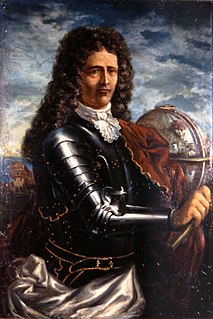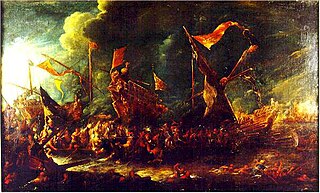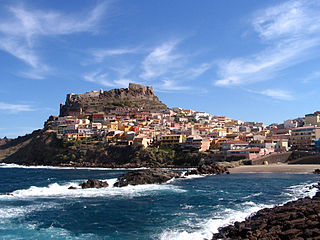
The Battle of Blenheim fought on 13 August [O.S. 2 August] 1704, was a major battle of the War of the Spanish Succession. The overwhelming Allied victory ensured the safety of Vienna from the Franco-Bavarian army, thus preventing the collapse of the reconstituted Grand Alliance.

The Battle of Ramillies, fought on 23 May 1706, was a battle of the War of the Spanish Succession. For the Grand Alliance – Austria, England, and the Dutch Republic – the battle had followed an indecisive campaign against the Bourbon armies of King Louis XIV of France in 1705. Although the Allies had captured Barcelona that year, they had been forced to abandon their campaign on the Moselle, had stalled in the Spanish Netherlands and suffered defeat in northern Italy. Yet despite his opponents' setbacks Louis XIV wanted peace, but on reasonable terms. Because of this, as well as to maintain their momentum, the French and their allies took the offensive in 1706.

Milazzo is a town (comune) in the Metropolitan City of Messina, Sicily, southern Italy; it is the largest commune in the Metropolitan City after Messina and Barcellona Pozzo di Gotto. The town has a population of around 31,500 inhabitants.

Admiral of the Fleet George Anson, 1st Baron Anson, was a Royal Navy officer. Anson served as a junior officer during the War of the Spanish Succession and then saw active service against Spain at the Battle of Cape Passaro during the War of the Quadruple Alliance. He then undertook a circumnavigation of the globe during the War of Jenkins' Ear. Anson commanded the fleet that defeated the French Admiral de la Jonquière at the First Battle of Cape Finisterre during the War of the Austrian Succession.

The War of the Quadruple Alliance (1718–1720) was caused by Spanish attempts to recover territorial losses finalized by the 1713 Peace of Utrecht. Conducted primarily in Italy, it included minor engagements in the Americas and Northern Europe as well as the Spanish-backed 1719 Jacobite Rising. Spain recaptured Sardinia in 1717 without opposition, followed by a landing on Sicily in July 1718. That led to the Quadruple Alliance on 2 August 1718 of Britain, France, Habsburg Austria, and the Dutch Republic. The war ended with the 1720 Treaty of The Hague, which restored the position prior to 1717 but with Savoy and Austria exchanging Sardinia and Sicily.

The Battle of Glen Shiel, or Scottish Gaelic: Blàr Ghleann Seile, took place on 10 June 1719 in the West Scottish Highlands, during the 1719 Jacobite Rising. A Jacobite army composed of Highland levies and Spanish marines, was defeated by British troops, reinforced by a Highland Independent Company.

The Battle of Stromboli, also known as the Second Battle of Stromboli or the Battle of Alicuri, took place on 8 January 1676 during the Franco-Dutch War between a French fleet of 20 ships under Abraham Duquesne and a combined fleet of 19 allied ships under Lieutenant-Admiral-General Michiel de Ruyter that lasted eight hours and ended inconclusively. The fleets fought again at the Battle of Augusta.

Admiral of the Fleet George Byng, 1st Viscount Torrington,, of Southill Park in Bedfordshire, was a Royal Navy officer and statesman. While still a lieutenant, he delivered a letter from various captains to Prince William of Orange, who had just landed at Torbay, assuring the Prince of the captains' support; the Prince gave Byng a response which ultimately led to the Royal Navy switching allegiance to the Prince and the Glorious Revolution of November 1688.

Thomas Mathews was a British officer of the Royal Navy, who rose to the rank of admiral.

The Battle of Cape Passaro, also known as Battle of Avola or Battle of Syracuse, was a major naval battle fought on 11 August 1718 between a fleet of the British Royal Navy under Admiral Sir George Byng and a fleet of the Spanish Navy under Vice-Admiral Antonio de Gaztañeta. It was fought off Cape Passaro, in the southern tip of the island of Sicily of which Spain had occupied. Spain and Britain were at peace, but Britain was already committed to supporting the ambitions of the Emperor Charles VI in southern Italy.

Count Wirich Philipp von Daun was an Austrian Field Marshal of the Imperial Army in the War of Spanish Succession, and father of the better known Leopold Josef Graf Daun. In 1710 he was created Prince of Teano.

The 1720 Treaty of The Hague was signed on 17 February 1720 between Spain and the Quadruple Alliance, established by the 1718 Treaty of London. Its members included Britain, France, the Dutch Republic and Austria.

Don José Antonio de Gaztañeta was a Spanish Basque ship-builder and sailor best remembered as the Vice-Admiral who commanded the Spanish Mediterranean fleet at the Battle of Cape Passaro against Great Britain on August 11, 1718, off the coast of Sicily. Gaztañeta's fleet was decisively defeated.
Jean François de Bette, 3rd Marquess of Lede was a Belgian military commander in Spanish service. He was also lord of the Fiefdom of Lede in Flanders.
The Battle of Francavilla was fought on 20 June 1719 near the city of Francavilla di Sicilia in Sicily, Italy between Spain and Austria as part of the War of the Quadruple Alliance.

Juan José Navarro y Búfalo, 1st Marquess of Victoria, OSJ was a Spanish military officer and first Captain General of the Spanish Navy.

The Kingdom of Sicily was ruled by the House of Savoy from 1713 until 1720, although they lost control of it in 1718 and did not relinquish their title to it until 1723. The only king of Sicily from the House of Savoy was Victor Amadeus II. Throughout this period Sicily remained a distinct realm in personal union with the other Savoyard states, but ultimately it secured for the House of Savoy a royal title and a future of expansion in Italy rather than in France. During this period, the Savoyard monarch used his new title to affirm his sovereign independence.

The Battle of Cape Corvo was a naval engagement of the Ottoman–Habsburg wars fought as part of the struggle for the control of the Mediterranean. It took place in August 1613 near the island of Samos when a Spanish squadron from Sicily, under Admiral Ottavio d'Aragona, engaged an Ottoman fleet led by Sinari Pasha. The Spanish were victorious and captured seven galleys and about 600 prisoners, among them the Bey of Alexandria and another 60 important Ottoman nobles. Cape Corvo was the first major victory of the Spanish fleets under Pedro Téllez-Girón, 3rd Duke of Osuna, the Spanish Viceroy of Sicily, as well as the greatest Spanish victory over the Ottoman Empire since the Battle of Lepanto.

The Spanish conquest of Sardinia, also known as the Spanish expedition to Sardinia, took place between 22 August 1717 and 30 October 1717. It was the first military action between the Kingdom of Spain and the Holy Roman Empire after the War of the Spanish Succession (1701–1714), and was the direct cause of the War of the Quadruple Alliance (1718–1720). The Spanish troops commanded by the Marquis of Lede and Don José Carrillo de Albornoz, 1st Duke of Montemar, supported by the Spanish fleet, defeated the Emperor's troops easily, and conquered the entire island of Sardinia, which had been ruled by the Emperor since the Treaty of Rastatt (1714), returning it again and for the final time to Spain.

From 1700 to 1720, the Kingdom of Sardinia, as a part of the Spanish empire, was disputed between two dynasties, the Habsburgs and the Bourbons. With the death of Charles II, the last of the Spanish Habsburgs, on 1 November 1700, the throne passed to Duke Philip of Anjou, although the Emperor Leopold I also had a claim. Leopold was especially desirous of obtaining the Spanish inheritance in the Southern Netherlands and in Italy, which included Sardinia. With the failure of France to abide by the Second Partition Treaty, the other European powers lined up on the side of the Habsburgs. The Treaty of the Hague allotted to the Emperor the Spanish possessions in Italy. Imperial troops invaded Italy to seize them, and the War of the Spanish Succession began.
















